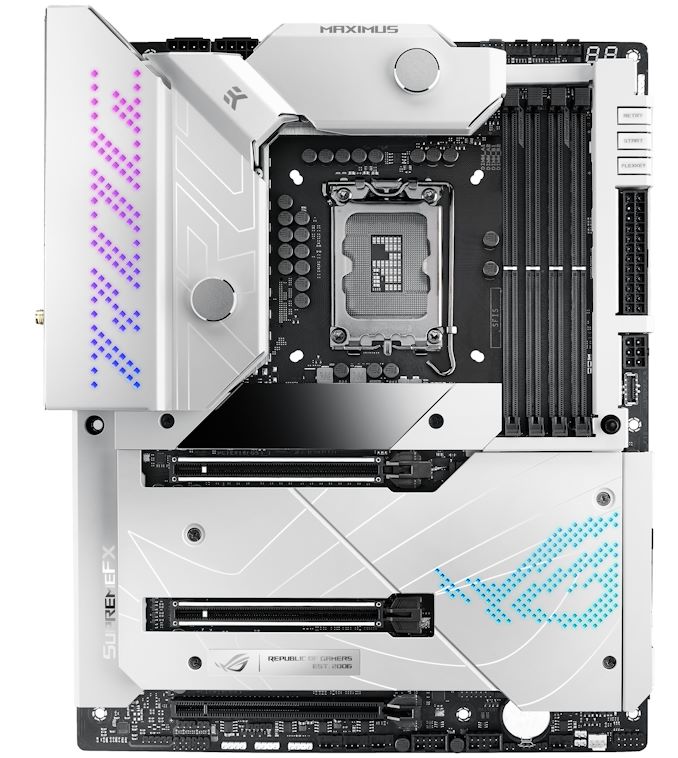The Intel Z690 Motherboard Overview (DDR5): Over 50+ New Models
by Gavin Bonshor on November 9, 2021 9:00 AM ESTASUS ROG Maximus Z690 Formula (DDR5)
Another mainstay of ASUS's ROG Maximus series returns for Z690, the ASUS ROG Maximus Z690 Formula. Fabled for its use of water-cooled VRMs, the latest Formula which ASUS actually skipped for Z590, is back for Z690 with a new aesthetic, including a new silver theme which is reminiscent of its Extreme Glacial models. The silver armor and heatsinks cover the majority of the PCB, with a custom milled EKWB heatsink cooling the power delivery, and allowing users to either passively cool them or hook them up to a custom water cooling kit for better VRM thermal performance. ASUS includes a fancy RGB-enabled ROG logo on the rear panel cover, with a similar design implemented into the chipset heatsink. ASUS is also advertising a large 20+1 teamed power delivery with premium 105 A smart power stages.
Dominating the lower portion of the board is plenty of PCIe and M.2 slots, including two full-length PCIe 5.0 slots operating at either x16 or x8/x8, with a third full-length PCIe 3.0 slot electronically locked down to x4. Touching more on M.2 support, the ASUS ROG Maximus Z690 Formula can accommodate up to five M.2 drives, including four with PCIe 5.0/4.0 x4 support, one with support for PCIe 3.0 x4 M.2 drives, and a total of six SATA ports with support for RAID 0, 1, 5, and 10 arrays. In the top right-hand corner are four memory slots with support for up to DDR5-6400, with a total capacity of 128 GB.
On the rear panel, ASUS includes two Thunderbolt 4 Type-C, one USB 3.2 G2 Type-C, six USB 3.2 G2 Type-A, and three USB 2.0 ports. There's a single HDMI video output for users looking to utilize the latest Intel integrated graphics, while five 3.5 mm audio jacks and S/PDIF optical output are controlled by a SupremeFX ALC4082 HD audio codec and ESS Sabre 9018Q2C amplifier pairing. Networking is very premium as expected, with one Marvel AQtion 10 GbE controller and an Intel-based Wi-Fi 6E CNVi offering both wireless and BT 5.2 device support. Lastly on the rear panel is a BIOS Flashback button and a clear CMOS button.











126 Comments
View All Comments
DanNeely - Tuesday, November 9, 2021 - link
Good point. I thought Intel was pushing hard for 12vo with the 6xx series, but it seems to be completely MIA.Silver5urfer - Tuesday, November 9, 2021 - link
Can I ask why ? What does ATX12VO provide to a consumer ?It doesn't make your mobo cheap, it doesn't make your mobo less complicated, it does not make your system run cooler, it doesn't make ADL consume less power, It doesn't even make any sense.
ATX12VO was created because of that trash policies set by policing state of California about some nonsensical rubbish. Servers and Data centers can get away with modular high density PSUs because of fully standardized set and they also get 3M liquid cooling. This is consumer market and here we have people wishing for backwards in technology.
meacupla - Thursday, November 11, 2021 - link
A lot of people had the same sentiment about EU RoHS restrictions, and yet, it was implemented worldwide.With that attitude, the same can be said about energy star, and 80plus certifications. It adds cost to the product, yet it offers not a thing to the consumer.
Not everything is about you.
We need to do everything we can to cut down power consumption, and ATX12VO standardization across the entire industry is very low hanging fruit.
Stop being so selfish, there's literally only one habitable planet we have right now.
Oxford Guy - Thursday, November 11, 2021 - link
80 Plus offered plenty to consumers. Less power use means quieter PSUs.The knock on 80 Plus was unrealistically easy testing. Despite that, it helped raise the efficiency of PSUs. Along with better efficiency, ripple, holdout time, voltage consistency, and other factors improved — as enthusiasts began to pay more attention to PSU quality.
I don’t doubt that 80 Plus also helped a lot of non-enthusiasts/amateurs by keeping them away from ultra-cheap PSUs that catch fire. Having a high-profile certification that those PSUs can’t reach helped to steer those customers away.
yacoub35 - Tuesday, November 9, 2021 - link
That white metal trim running tight around the molex power connector on the ASUS ROG Maximus Z690 Formula must make it an absolutely nightmare to plug/unplug the main power cable to the board.Ranguvar - Tuesday, November 9, 2021 - link
Correction:"Previously with 11th gen (Rocket Lake), Intel upheaved it from a PCIe 3.0 x4 uplink on Z490 to a PCIe 3.0 x4 uplink on Z590."
This should say "to a PCIe 3.0 x8 uplink on Z590".
OFelix - Tuesday, November 9, 2021 - link
Correct. And whilst we are correcting that sentence - "upheaved" ????This first page really needs to be read by an AnandTech editor.
What's that? They don't any editors? :-(
OFelix - Tuesday, November 9, 2021 - link
"Z490 Motherboard Audio" ... presumably Z690?mode_13h - Friday, November 12, 2021 - link
I caught that, as well. Even the word "upheaved" is itself somewhat noteworthy. Plenty of better alternatives: "upgraded", "widened", "expanded", "increased", "enlarged", etc.GeoffreyA - Saturday, November 13, 2021 - link
While "upheaved" is likely an error, it's not far off from the words of today. Unfortunately, the English language is on a downgrade, and it's just going to get worse and worse. The language's genius is not tuned to the over-economical forms we're finding today; and a lot of it seems to be coming from tech. Upthis, upthat. My favourite, though, is leverage. A big, scary word that companies are fond of, and which escaped its programming, game development roots. Soon, we'll be leveraging the kettle to make tea. How about using?